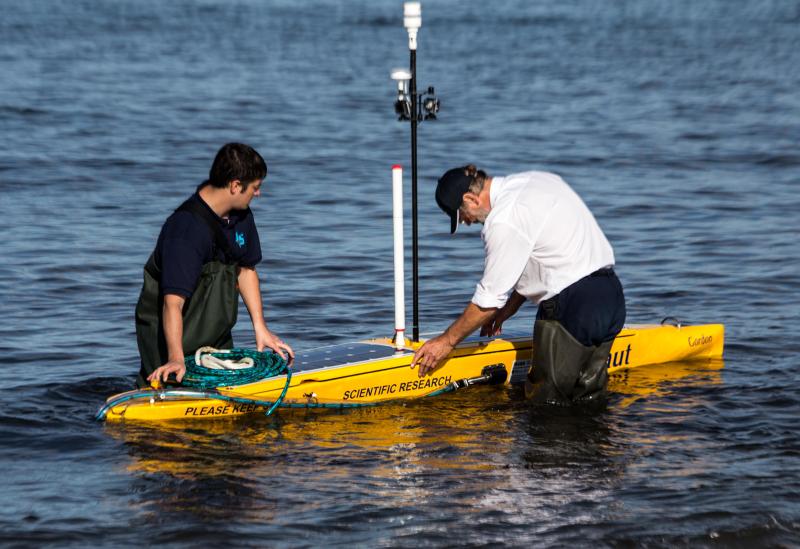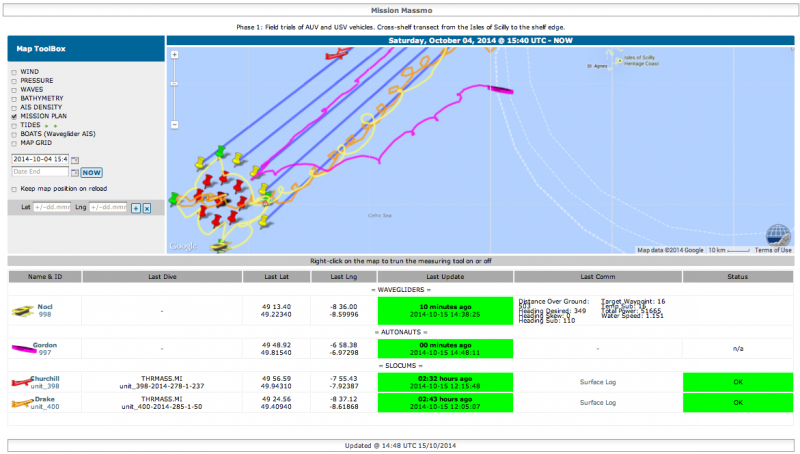Project update – Gathering data
This week, the Exploring Ocean Fronts project is living up to its name, as our unmanned surface vehicles and submarine gliders continue to actively gather information from the open ocean far from land. They are looking at the physical properties of the ocean, such as temperature, salinity and chlorophyll, and continue to successfully navigate the recent high tides and strong winds.
AutoNaut reached a group of buoys 160 km southwest of the Isles of Scilly early on 12 October. After collecting information through a tidal cycle, it then headed northeast back towards the islands. Recovery took place on 17 October. During AutoNaut’s twelve days at sea it travelled in the region of 400km. We will soon know whether the internal logging sensors, such as the cameras and acoustic array, have collected valuable data... all will be revealed in the next few days!
 The NOC-L SV2 waveglider has successfully undertaken a clockwise circuit around the buoys in recent days and has been taking measurements for sensor calibration and for comparison with information collected by the buoys. The vehicle is currently located just south of the buoys and will be continuing to collect meteorological and sea-level data for various scientific purposes.
The NOC-L SV2 waveglider has successfully undertaken a clockwise circuit around the buoys in recent days and has been taking measurements for sensor calibration and for comparison with information collected by the buoys. The vehicle is currently located just south of the buoys and will be continuing to collect meteorological and sea-level data for various scientific purposes.
Both submarine gliders are performing well and are also sending back valuable data. Submarine glider 400 is travelling between the buoys, also collecting information for sensor calibration and comparison, and to feed into wider shelf seas studies. Submarine glider 398 is currently heading southwest towards the buoys after completing its crossings of the Scilly front.
The data being collected also demonstrate the value of autonomous vehicles continuously collecting profiles through the water column over periods of several weeks, as the impact of recent storm events and seasonal (autumn) changes on the oceanography and biology of the ocean can be assessed.
The waveglider and the two subs will remain in the area around the buoys for another few days, until RV Cefas Endeavour arrives to recover them. As well as collecting useful scientific data, this period is giving the glider pilots at the control centre in Southampton and Liverpool an opportunity to test various aspects of vehicle control in different tidal and weather conditions.
The Cefas SV3 waveglider Lyra was recovered last week by THV Patricia and has been taken back to Cefas. The vehicle was severely damaged during the first storm about ten days ago, but it looks like she collected some valuable data during her week at sea.
We are now looking towards the start of Phase II of the project and preparations are well underway. The phase involves seabed acoustic receivers and tagged fish (more details to come!) plus robotic vehicles. We are currently looking at 3 November as the likely target date for deployment of the vehicles for this phase.

On a related note, we are also delighted that our project has caught the attention of the British Science Museum and we have been invited to display our fleet there during half-term between 28th and 30th October. We will have full-size versions of the C-Enduro, AutoNaut and a Seaglider (a display model, supplied by the University of East Anglia).
The project also featured on the NERC Planet Earth podcast series.
